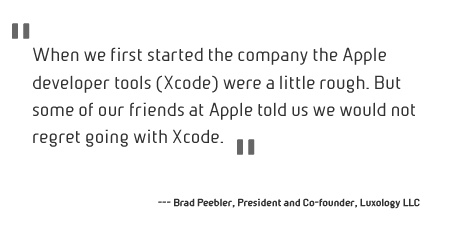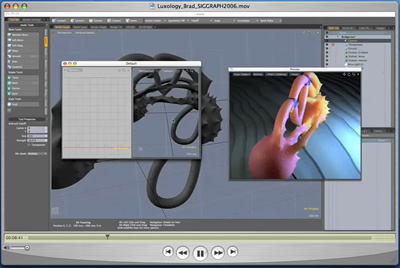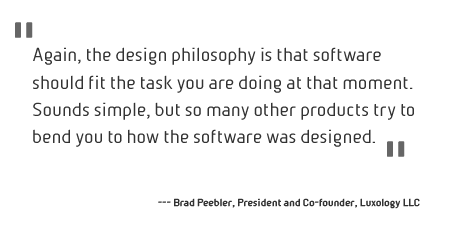|
Let's
switch gears a bit. modo has been showcased in previous
Steve Jobs' keynotes and just recently Luxology won an
Apple Design Award at this year's Apple WWDC. Obviously,
you guys are a hit when it comes to Apple.
We
love Apple and Apple products. Every version of modo we sell
contains a license for Mac and Windows platforms -- so
Windows users have "no" reason not to get a Mac. They
already have the license!
Apple
has been very good to us and we have come to know many
of the people there as friends. They are not far from
us here in the valley.

When
you first started modo was the Mac platform part of your
target platforms? Did you develop it from the beginning
using Apple's developer tools? How important is the Mac
platform to Luxology?
The
Mac is central to what we do. I use one personally not
just for modo but for everything. I love Aperture, Keynote
-- all that stuff.
And
yes, we use Apple's developer tools. We had our top Mac
programmer, Matt Craig, go to WWDC when we got the Apple
Design Award this year. Matt was so into it he was going
crazy! When
we first started the company the Apple developer tools
(Xcode) were a little rough. But some of our friends
at Apple told us we would not regret going with Xcode. We
took them at their word and in many ways we have been
able to assist Apple in improving Xcode, Shark and GL
Profiler.
Making
the move to their [Apple] developer tools was one of
the best decisions we made on the Mac. I have to credit
Matt Craig here for that one.

How
important is it for you guys to be recognized for the
Apple Design Award?
As
a small company it feels really good.
We
don't get all the kudos that some of the bigger packages
like Maya get and so we appreciate such a highly-regarded
accolade from Apple. The award is kind of like a milestone
that will always be there for us. So often people do
not pause to go, "hey that went well" it is always an
attitude of let's get onto the next thing right away.
The Apple Design Award kind of forces us to relish the
moment, and everything we've accomplished with modo.

modo
has received much praise for its interface design. Who
is responsible for it at Luxology? Is this one person's
magic -- genius -- or is this a team effort?
There
is only one team of developers at Luxology and yes, it
is a team effort. There are two very different things
that people refer to when they praise our user interface
(UI). One is simply the look. The app just has a really
nice clean look to it. This was very definitely a group
effort. I will give some credit to Allan Hastings for
the original design prototype on the icons and to Mark
Brown who created about 98 percent of the icons you see
in the app. It's not easy to represent a "vertex slide"
operation in 32 by 32 pixels!
The
other area where we spark a lot of interest is in the
fluid nature of the UI. The "feel" of the app. There
was a core mantra internally that has driven the app
this far in terms of customizability and this is that
"the user always knows best."
Ultimately
the user should be able to change the application to
best fit his or her workflow. Again, the design philosophy
is that software should fit the task you are doing at
that moment. Sounds simple, but so many other products
try to bend you to how the software was designed.
Is
animation in the works for modo?
Right
now, animation is the domain of products like Lightwave,
3ds max and others. Accordingly, we put a lot of work
into making modo work cleanly with those applications
both from the data standpoint and also the little things
like making the navigation of modo able to be set up
like Maya.
Many
of our customers actually like the simplicity of not
having animation controls in their face. If you just
want to crank out a design visualization, or test how
your product packaging will look like, or build an asset
for a game, you may not need animation.
As
for Luxology, we came from an animation background and
we are anxious to bring something to market. When and
how it comes to market is in a future chapter!
Thanks
for taking the time Brad.
Thanks
for the opportunity.
page:
| 1 | 2 |
|






![]()
![]()